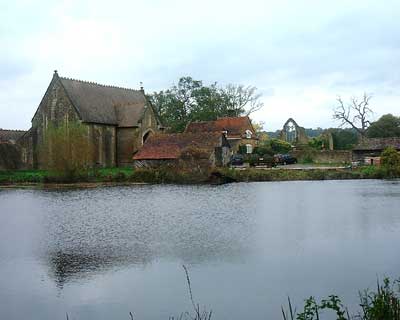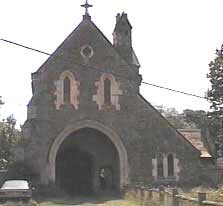





Oxenford was first a medieval dependency of Waverley and then the original site of Peper Harow House. It now consists of a big 17th century farmhouse, Oxenford Grange, and two farm buildings designed by Pugin in 1843, a barn and a gatehouse, which are considered to be among his best buildings.

Sometime before 1147 Richard de Aquila granted Oxenford to Waverley Abbey, and this grant was continued in 1147 by a papal bull. From then until 1536 Oxenford was a Cistercian monastery farming for Waverley Abbey.
In 1536, in the reign of the Henry VIII, it was granted to Sir William Fitz-Williams, Earl of Southampton, together with the other estates of the monks of Waverley. Eight years later, in 1548, it was passed under a settlement to his half-brother Sir Anthony Brown and then to his son Viscount Montacute. According to the Loseley manuscripts there was a house there occupied by Anthony Garnett, secretary to Lord Montacute. Mr Lusher, probably of Elstead, who was a nephew of Anthony Garnett, then leased it, followed by a Mr Spencer who was considered to be a Romanist of doubtful loyalty.
In 1624 John Chesterton, who then owned Oxenford, died and the estate was divided between his three daughters. Two shares were bought by Sir John Platt of Westbrook in Godalming and the third share by Chesterton Fox of Godalming. Sir John Platt sold his shares to Denzil Lord Holles in 1676; after the latter’s death an Act of Parliament was passed authorising the sale of the estate to pay his debts. In 1699 Philip Frowde bought it with the rest of the Peper Harow Estate and in 1713 it was bought by Alan Brodrick, later Viscount Midleton.
The third share that Chesterton Fox owned was sold to the Stillwells of Mousehill and this was bought from them, together with the Mousehill Estate, in 1822.
In 1881 Henry Evershed Carter became a tenant of Oxenford and Amberley, jun taking over from William Chalcroft, but within five years he had given them up and Mr Lewry took on Amberley.
On September 29th 1887 Mr Jonas Baker leased land totalling 129 acres, 22 poles, including Bagmoor Cottage, for £100 per annum. He was obviously a man of means, for by 1896 he had also acquired 135 acres in Witley Parish and 36 poles in Thursley Parish.
Albinia, widow of the third Viscount, lived in and enlarged the old building of the Grange. The fourth Viscount also lived there while the new mansion of Peper Harow was being built.
1775: with the new Peper Harow mansion built most of the Grange was pulled down except what was converted into a Cottage and what is now covered with ivy. 1841-1848 Pugin built a group of extravagant Gothic farm buildings, i.e. the Barn, Cowfold, the Gatehouse, Bonville Spring, Oxenford Bridge and the Chapel Ruin and rebuilt the rear of the farmhouse and its chimneys.
"We present that our curate Sir Henry Weynwright doth not inform the youth
of the parish in their catechism as by the queen's instructions are appointed.
The said Sir Henry Weynwright is suspected of incontinent living with one
Joan Massy who he sayeth is his kinswoman for presumption whereof we find
that the said Joan doth sundry time resort to the house of the parson
Sir Henry secretly and suspicion lie and the said Sir Henry and Joan were
once attached in Oxenford and entered into 'buccardo' for the same."


The Gate House, the barn and associated structures, plus the house make a lovely group of buildings.
In 1842 Pugin designed and Myers built the Gate House it is a substantial building with accomodation above it.
There is a turret with a weather vane and a huge arched gateway with stone lions heads either side. On the inner boss of the arch is carved Lord Midleton's coat of arms and on the outer boss is carved an ox crossing a ford, hence Oxenford.
(Info from Pugin.com)

The barn is so attractive and to find it in its original use is really gratifying.
It is large, sturdy and smelling wonderfully of hay, with its lofty roof structure huge barn doors and cows mooing in the yard it felt truly right.
Pugin's theory of 'natural architecture':'In matters of ordinary use a man must go out of his way to make a bad thing.'
(Info from Pugin.com)